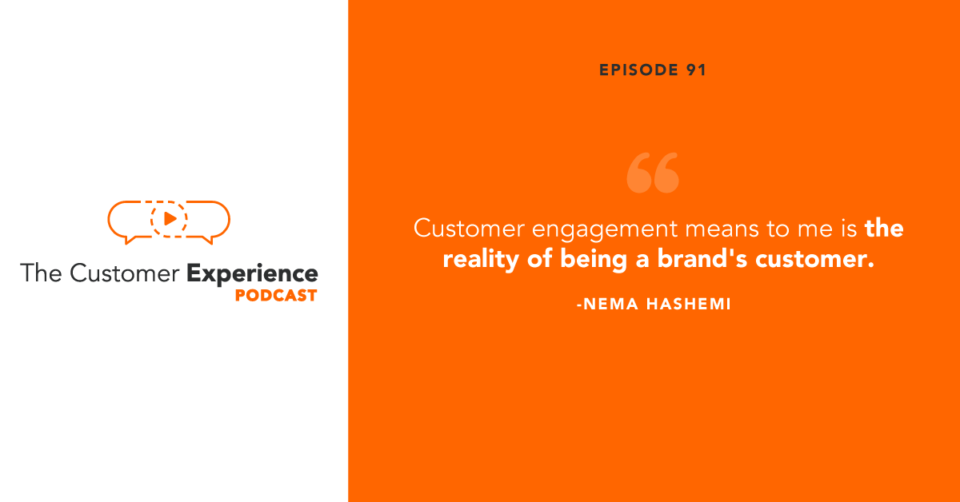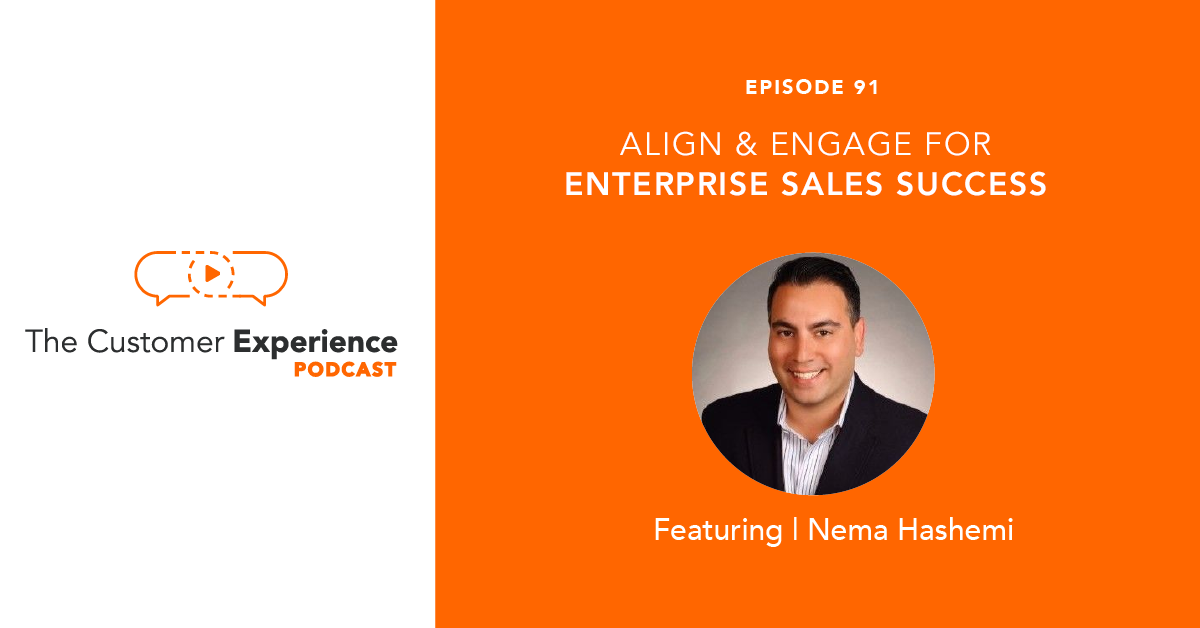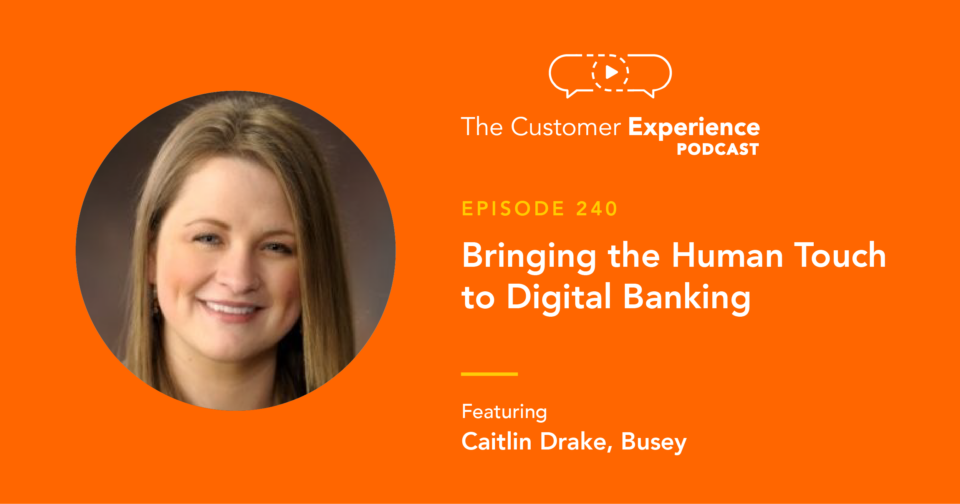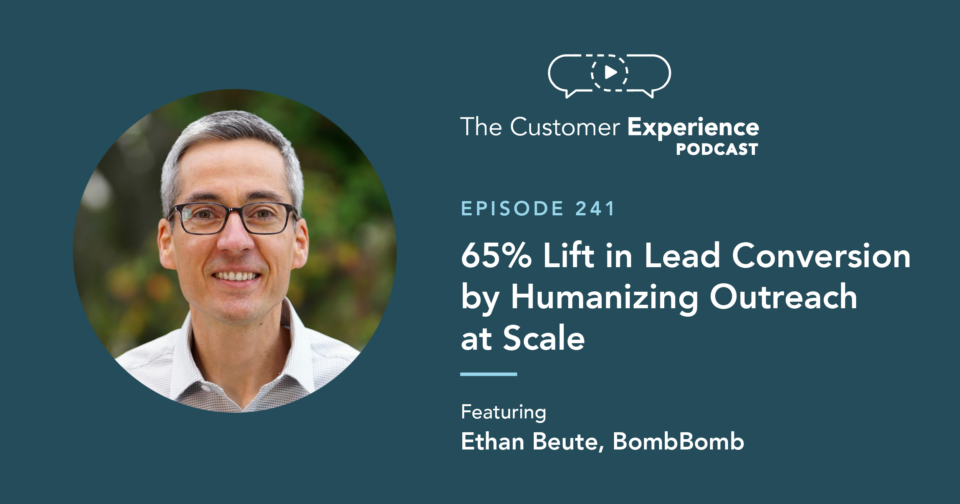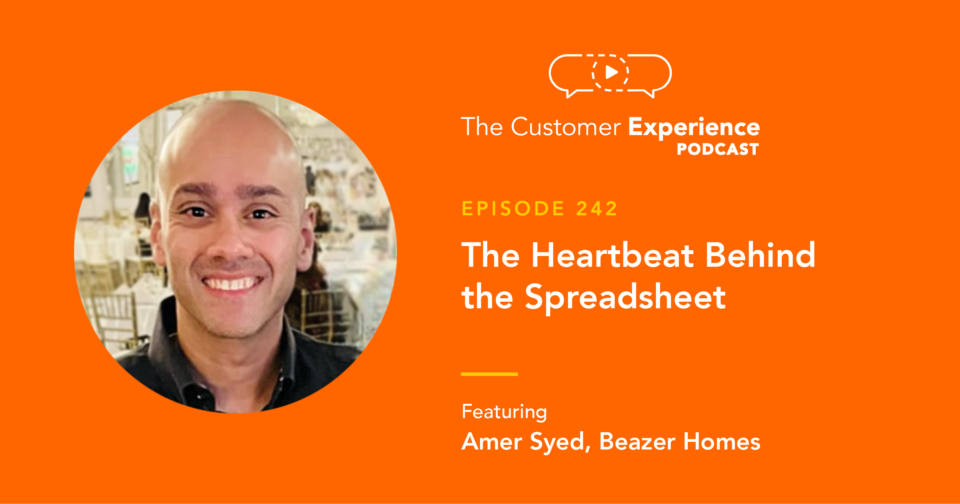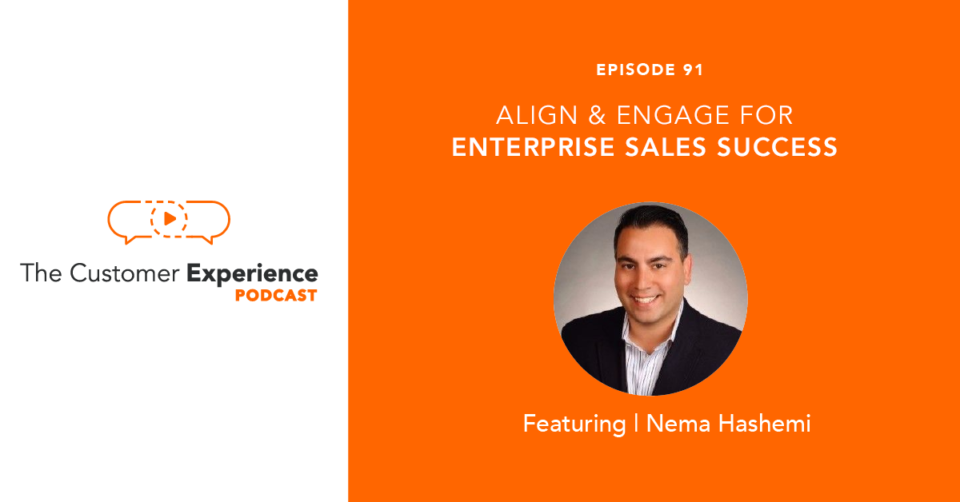
Listen to “91. Align & Engage for Enterprise Sales Success w/ Nema Hashemi” on Spreaker.
Apple Podcasts | Google Podcasts | Stitcher | Spotify
The moment people interact with your brand, they’re engaging with it. This engagement – whether it occurs by phone, online, in a store, or anywhere else – is what defines and shapes your customer experience.
In fact, without effective engagement, the customer experience doesn’t exist – at least not in any meaningful way.
Our guest on this episode of The Customer Experience Podcast is Nema Hashemi, Director of Sales at Contentstack – a modern Content Management System (CMS) designed to deliver personalized, omnichannel experiences. And he is all about engagement on both a customer and an employee level.
Known for pioneering headless CMS, Contentstack has a consistent renewal rate of 95%. This comes down to Nema helping to close the gap between abstract technology terms and true engagement by roping customer success into the sales process, hiring for a diversity of experience, and providing one consistent hub for delivering content.
We talk about…
• What the relationship is between engagement and customer experience
• What exactly headless CMS is – and how it differs from a traditional CMS
• How sales is involved in customer success (internal alignment)
• Why the present need is to move as fast as possible on content
Align & Engage for Enterprise Sales Success
Hear the entire conversation with Nema Hashemi of Contentstack right here:
Listen to “91. Align & Engage for Enterprise Sales Success w/ Nema Hashemi” on Spreaker.
Hear this episode of The Customer Experience Podcast – and many others – by subscribing to in:
Click one of the links above to visit your preferred podcast player. Then, please subscribe, rate, and/or review the show. Just one minute of your time is extremely helpful!
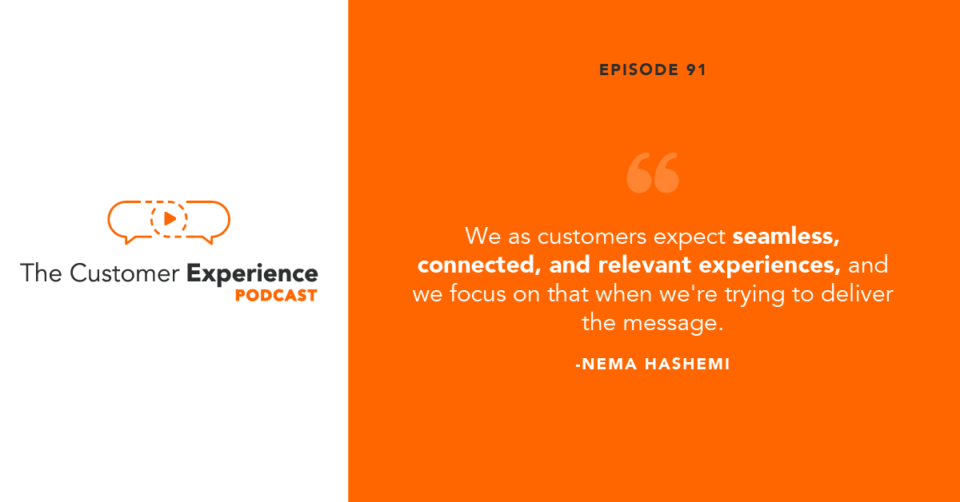
Full Transcript: Align & Engage for Enterprise Sales Success
Ethan Beute:
Creating engagement and communicating the need for change, the need for transformation, these are key to customer experience, and in fact, to employee experience. Today we’re talking sales, change, and engagement with a gentleman who’s served in a variety of sales roles and sales leadership roles for nearly two decades, including director of sales at Wearable World Labs, Bluenose Analytics, and Bulit.io. He currently serves as director of sales at Contentstack, a company that brings business teams and technology teams together to deliver personalized omnichannel digital experiences for customers like VMware, Chase, Cisco, Walmart, Sephora, Icelandair, and the Miami Heat, among many other familiar names. Nema Hashemi, welcome to The Customer Experience Podcast.
Nema Hashemi:
Glad to be here, Ethan.
Ethan Beute:
Yeah. Thank you so much for making time. I’m looking forward to getting into it, but one of your offices is in San Francisco. You are in Oakland. Kind of set the scene. What has the pandemic done to you, your business, your customers? What are a couple high-level takeaways here as we’re recording in mid-to-late June?
Nema Hashemi:
Yeah, absolutely. I mean, I think around the world… We work with customers all around the world, and everybody’s been hit. I don’t think anybody has been immune to what’s happened with the pandemic. I think on the one hand, it’s been unfortunate that we haven’t been able to gather in our San Francisco office. We also have offices in Austin and in India. Everybody’s been working from home since early March. On the other hand, it was great to see our leadership team step up and make decisions quickly and swiftly, with the best interests of the employees in mind, and also working with customers through this difficult time. It’s helped create a more solid bond, but I think where we have been affected is just things kind of paused a little bit on the sales front as companies were trying to figure things out.
Nema Hashemi:
We work with large companies, and the vast majority of those are public companies, so they had pause in spending that affected us a little bit. Just personally, not being able to go into the office every day, it’s been three months since I went into the office, and not being able to interact directly with the team, but on the other hand, we were set up pretty well. Most of our employees, if not all of them, had a setup for work from home. Our technical support team was able to step it up in the first few weeks and support the employees working from home even more, and so I think we’ve done pretty well, all things considered.
Ethan Beute:
Nice. I really appreciate the idea that you feel like leadership made the right choices for the benefit of the employee. That’s where a great customer experience starts, with a satisfied, engaged employee that feels secure and appreciated, and so really good words. Thank you for sharing that. I want to learn more about Contentstack, but first I’m going to ask you a couple definitional questions, and the first one is customer experience. When I say that, Nema, what does that mean to you?
Nema Hashemi:
I think it’s twofold. One is customer experience, when I think about it, it’s this is what it’s like to be your customer, but when you kind of take a step back and look at it in greater detail, I think the brand is what the company wants their customers to think they are, and the customer experience is the reality check of being your customer. So, I think that’s what it means to me. What is the reality of being a brands customer?
Ethan Beute:
I love it. I like both of those angles there. One, I often bottom line customer experience, if I want to really simplify it, as how you make people feel, which was essentially to your first one, and then to the second one, this idea that the customer’s reality is the reality. You can think and feel and say whatever you want, you can even have a rhetoric or a rebuttal to some kind of customer feedback, but the fact of the matter is the customer gets to define what reality is and what their experience is, so I like that. One more definition here. When I say engagement, what does engagement mean to you? It’s one of those slightly… It’s critical, I think, to the work that you all do and the value that you provide your customers, but it can also maybe be a little bit slippery. When I say that, what does it mean to you?
Nema Hashemi:
Engagement is, I think, that direct action of the brands interacting with the customers, or the prospective customers, so that moment when you are on a mobile app or on a website or entering a store, from that moment on. When that happens, to me, that’s engagement.
Ethan Beute:
Cool. So, for people who aren’t familiar, tell us a little bit about Contentstack. Who is your ideal customer, and what do you solve for them?
Nema Hashemi:
Yeah, absolutely. At a very direct level, we are a content management solution, so we’re a technology company, and the product that we have is a content management solution. We make it possible for businesses to create and publish content faster. It does go much deeper than that, but that’s essentially what we do. We are a software as a service, so all that means, for those that are not familiar, is that your product is in the cloud. It’s hosted, so you don’t have to… If you think back decades and decades ago when we would get the CDs for AOL, and you’d have to update manually, so that would be more of a traditional software, embedded software, where we’re in the cloud, so it’s like logging into your Gmail account. The updates happen seamlessly, and seamless updates and upgrades. But that’s what we are. We’re a content management solution. We’re a SaaS company, and we help our customers deliver a more succinct and consistent customer experience for their customers.
Ethan Beute:
Nice, and of course, I listed in the introduction there some very, very large companies, very well-known brands. Is that the typical customer? What is the range of folks that you serve?
Nema Hashemi:
Yeah. So, we made a decision very early on to only work with large customers, so the vast majority of our customers are public companies and have been around for a long time. One of the reasons that we made that decision is we came from a professional services background, so we were really used to this partnership approach of working with customers, and we realized that that’s where we wanted to focus on. There are other CMS vendors that focus on individual developers, slide your credit card, pay $99 a month, and you get to use their services. We are only focused on what we term enterprise companies.
Nema Hashemi:
Now, there is a range in the size of the companies that we work with. Smaller companies that are completely digital are more likely to invest in a product like Contentstack’s, but because of our price point, we do kind of filter out the smaller customers and the smaller prospective customers. So, as a result, all of our customers are very large companies that invest quite a bit with us, and we, as a result of being at a higher price point, are able to work more closely with them and partner with them rather than just be a vendor.
Ethan Beute:
Yeah. I really like that discipline. I think a lot of folks try to do more than they can do super, super well, so I appreciate that there is some heritage or some DNA around professional services and what that means for the nature and the depth of the relationship, and that you continue to honor it in a more traditional SaaS offering. So, what is your background? Is this enterprise sale something you’ve done for years and years and years, or is this something that you’ve had your toes in multiple pools of multiple depth? When you joined the company, how familiar were you with what I assume is probably a complex enterprise sale with maybe a, what, three-to-six-month cycle or something?
Nema Hashemi:
Yeah. That’s a great question. So, my background, I started in 2008 in technology sales, and the company I worked with at the time, Lithium, they were a provider of online customer communities. That was right when social media was really starting to gain steam from a business and enterprise perspective, and throughout the duration of my career, I’ve focused almost solely on working with enterprise customers. So, about 12 years of technology sales background all dealing with large customers. When I first joined the team here, we were actually a company called Built.io. I was the first sales hire and started the sales team here at the company. At the time, we had professional services, and we also had three products. We were really trying to figure out where we wanted to go, and it was very interesting, and a good learning experience, I’d say.
Nema Hashemi:
At the beginning of 2018, January 1st, 2018, we completely rebranded our company and focused just on the content management piece. Prior to that, one of our products was Contentstack, and then as of January 1st, 2018, our company, the rebrand, we were Contentstack. We spun off the other products and services and just focused on the content management piece. But throughout the time, the focus has really been on the enterprise approach because that allows us to better partner with our customers and to ensure success. What we want to avoid is looking back and saying, “Wow, we could’ve done more for this customer to make sure that they were successful,” and the only way that we can really do that without losing money is by having the higher price point and making sure that we have skin in the game, but that the customer has skin in the game as well, and so it lends itself really well to enterprise.
Ethan Beute:
Nice. I like the focus and discipline in there too. It’s like, yeah, we’re capable of doing these other things, but let’s focus on what we can be expert at and do really well. So, when I think about the sales process, and really, any kind of a customer engagement, a customer experience, there’s some aspect of a transformation in there. There’s a change in there. From a sales standpoint, it’s helping draw the vision for that change, creating the trust and confidence that we can manage change with and for you. For your customers, where are they when you first engage with them? What is the state of affairs, and where do you bring them? What kind of transformation, what kind of change, and maybe, also, what kind of resistance do you get, or what types of resistance are you typically fighting, and how do you do that?
Nema Hashemi:
Yeah. So, I’d say from day one we are working with our customers to help figure out how they can make their messaging more effective and their teams more effective, and their businesses more effective. So, I’d say from day one, for us it’s really about a partnership, and that’s something that we help differentiate. So, for example, when you look at a lot of our customers, Lego, Levis, Burberry, The Spectator, The Spectator’s been in business for almost 200 years, these are businesses that have been around for a long time. Their challenge is not creating content. Most of the customers we work with have a content management system in place and a content management process in place, but their challenges are twofold.
Nema Hashemi:
Their teams cannot create the content and publish it at the speed that they desire, and there’s also perhaps some internal struggles going on, where they’re on an old system that’s only maybe about 50% to 60% of their ideal capacity, or they have technical folks helping publish content for business users. Business users aren’t able to publish at their own speed. So, when we come in, there’s already something in place that they’re doing, and what we’re trying to do is help them be more effective and be more efficient, and that really is the whole reason for headless. We are one of the, if not the first, headless CMS out there. We have been named a pioneer in the space, and again, depending on who you ask, we were either the first or one of the first.
Nema Hashemi:
So, we realized early on that if you separate code from content, allow the business users to focus on what they’re best at, which is being creative and creating content, and then you focus on allowing the technical users to be good at what they’re good at, allow the experts to be experts, allow the technical folks to create new products and to secure the digital presence and things like that rather than pushing out content, what you have is much more cohesiveness. So, that’s really what we enable our customers to do, is to publish content more quickly, but also have a safe and secure presence out there so they’re not being hacked, catastrophic things like that aren’t being… They aren’t being taken advantage of.
Ethan Beute:
Really interesting. I am not familiar with headless, but where I am with you right now, and so correct me and steer me back or whatever, is that it’s the separation between… I’ve published, I don’t know, hundreds of blog posts at BombBomb over the years, and I’m not particularly technical, but I will get into the code, but when I need something legit to happen in our blog, I need to go to developers. So, is it the separation of the content producer or content creator from the developer that is tied to this headless? What does headless mean?
Nema Hashemi:
Yeah. So, headless-
Ethan Beute:
Am I close?
Nema Hashemi:
Yeah, you’re very close. So, what it means is if you look at a monolithic CMS, something like WordPress or Adobe or Sitecore, those are… Drupal’s another really popular legacy monolithic CMS. They give you everything. They give you the design, the UI, the templates, but the content is hard-coded in. What we did is if you look at the front end, the UI and the design, the look and feel of a website, if you look at that as the head, and then the content itself is on the backend, what we did is we chopped off the head. So, that’s where they got the term headless. It was developed by Forrester Research, so that’s an analyst term, but it’s the one that really caught on. But that’s really what it means, is you and your team, your IT team, your development, and engineering team, can create the look and feel of the website.
Nema Hashemi:
I’ll use Lego as an example. So, the lego.com website or the Lego app, they create the look and feel, and then the content creators are in the background creating the content. So, when you see Lego comes out with a new Batman toy, or they are launching a new movie, all of the content around that is created by a team of content creators, and what we enable Lego to do… What they had to do prior to coming to Contentstack is every time a content creator created a piece of content, they would then have to bring a developer in. Developers are high-cost resources, and they are hard to find. So, even if you have the money to hire them, it’s very difficult to find them. So, they had to bring them in, and the time it took would be about a week or two to get that content onto the website in a secure fashion.
Nema Hashemi:
What they are able to do now is to move much more quickly. In a matter of minutes, if not seconds, assuming all the boxes are checked around approvals and permissions and so on. So, we enable Lego’s team to move much more quickly, and as we’ve seen, especially over the last few months with COVID and the pandemic, but also with the social unrest around the movement that has taken the world really by storm, companies have had to move really quickly. They don’t have weeks to announce their stance on the pandemic and what they’re doing, or their stance on things like Black Lives Matter. They’ve had to move much more quickly, and our customers, we’ve enabled them to do exactly that as they see fit, whereas if they were on their legacy systems, they may not have been able to move as quickly.
Ethan Beute:
Cool. Give me a little bit of an operational pass on this. So, headless, coined in part by Forrester, probably with you all, new category, or essentially, a subcategory, because CMS, as you said, there are some legacy monolithic opportunities hanging around. What did taking on this headless concept or this category, let’s call it, or subcategory, what did that mean for you and your sales team and customer conversations? Was there training around it, or was this so deeply baked into the company that it all just kind of happened naturally? Specifically speaking to headless, and I’m now holding that as an example of category design or a new way to talk about the product, a new way to create a sense of differentiation because you’re very clear on the benefits of making that separation that is headless, how did that go for you all internally, and what was the customer reception like to that message? Because I’m sure my ignorance that I just shared with you and with everyone listening, I’m sure some of your customers were maybe in the same boat, at least for some period of time.
Nema Hashemi:
Yeah. I wish I had a great story to tell, but it all happened by accident, and I know my CMO’s going to kick me for saying that, but really, what happened is when I joined the team, at the time, we were much more focused on mobile. We were building mobile apps, and Contentstack was a piece of that. We actually were ahead of the market. The market wasn’t really ready for it in 2015, and then about early-to-mid 2016, we noticed this critical mass, if you will, of interest in headless CMS. So, there are two examples that come to mind, Express, and Photobox. Photobox is an online retailer based in the UK, and Express is the retailer here in the US that sells clothing goods.
Nema Hashemi:
They came to us, did an evaluation, and decided to go with Contentstack. We had a great team. We’ve always focused on creating quality products, and it was right then, and again, this is kind of an internal story that I’m maybe sharing for the first time externally, but I was at a conference with my CEO and CMO. It was in Phoenix, and around this time, it could’ve been exactly this date or close thereabouts… So, as you know, in Phoenix, in June it’s extremely hot. We had been at this conference for about two days nonstop, and we had about an hour to kill, and they had the pool with the water slide.
Nema Hashemi:
So, we all looked at each other. We’re like, “Let’s go get a drink, and let’s go to the pool,” and I’m sitting at the pool. My CEO and CMO are in the pool, and I told them, “Hey, guys, we just closed this deal,” and at the time it was on the higher end and a much shorter sale cycle than the majority of our deals, and I saw the wheels turning in their heads, like, “I think the time is right now for headless CMS.” So, it’s a great story. It’s kind of how we started to pivot our focus and just focus on headless CMS, but we noticed that the term was starting to gain steam.
Nema Hashemi:
Customers were really feeling the pain of this monolithic, traditional approach to managing content. They needed to move faster. The focus on digital was there, and that was really what carried us. When we asked one of those customers, “How did you hear about us?” they said that they were eight months into a nine-month project using a traditional CMS, Adobe, that they were going to go beyond their timeline. It was going to almost prevent them from being able to deliver before Black Friday, because the Black Friday sales, which in retail is a big no-no. They did some research on Google. They found out about us, and then that’s what led them to us in the first place. So, I would think the market itself, the innovators at those customers, and Google, that’s really what allowed us to pivot, focus on this, and the market has really caught up since.
Ethan Beute:
Nice. So, I assume that that’s the gap that exists between business teams and development teams. When I look at your website, I see how you’re positioned. That’s really speaking to this situation’s divide, this challenge that slows things down.
Nema Hashemi:
I would agree. I think now we’re seeing a lot more cohesiveness, even internally, because they know there’s a better way, and where we really focus on is helping customers and prospective customers understand the difference between a true headless and a legacy system that has an API layer on top of decades and decades of legacy technology, and they are using the term headless CMS. That’s really where we focus on differentiating now. It’s also helping prospective customers, and even existing customers with different business units, understand the benefits of that true headless approach. It’s difficult to change.
Nema Hashemi:
So, if you’ve been on Sitecore or Adobe or Drupal for decades, there’s a lot of legacy systems. There’s a lot of heavy lifting you’re going to have to do to make the change, but once it’s done, life is much simpler, much easier, and it’s not just from a day-to-day perspective. It’s not just about being able to publish content out quicker and more easily, but it’s also about not having to manage custom widgets and custom integrations that you built. Once you put in that effort initially, then you can move more quickly all around rather than continuing to do all of the things that you’ve done in the past just to keep things going, just to maintain what you’ve built.
Ethan Beute:
Yeah. I would assume that that transition off of something so deep and layered, that I would assume that there was some emotional switching cost, if not cognitive, if not financial switching cost to this shift. What kind of training and coaching do you provide your team members to draw out a vision, to inspire trust and confidence that… My read on you and the situation is that you probably white glove and you go above and beyond to make that transition easy, but when a prospect or a prospective customer is on the outside looking in, how are you training and coaching your team to kind of manage those expectations and inspire trust and confidence that what seems like would be very daunting is actually manageable, and we’re your best partner for that?
Nema Hashemi:
Yeah, that’s a great question. I’d say our biggest enemy is our enemies. So many software vendors out there have overpromised and underdelivered throughout the years that there is that skepticism amongst new customers, prospective customers, when we tell them, “This is what life is like with Contentstack.” Internally, it’s very easy to train the team because we have a great product that works, and we have a customer success team that helps provide that white-glove service once a customer is onboard officially, and we provide free trials. So, customers can go in and test out the product in a live production, in a sense, and really test it out for themselves.
Nema Hashemi:
So, where we focus on is helping customers do the right type of testing ahead of time so that they don’t make a mistake in making a decision, but again, it makes… Our life is much easier because we know we have a great product that works. We have a lot of referenceable customers. Our renewal rate Q1 of this year was 100%. We’ve consistently maintained a renewal rate above 95%. Even when customers do leave us, it’s not because the product doesn’t work. It’s extenuating circumstances that there’s not really much we could do anyway, or they’re on legacy-type pricing, and it doesn’t make sense for the business.
Nema Hashemi:
So, I think for us it’s really easy. We know our support team responds incredibly quickly. We know that they’re effective, and they work with our customers to identify issues that they’re dealing with and fix them. We know our customer success team is helping customers in understanding their vision and what they need to do to achieve that vision, and we know that the product team is consistently creating the best product out there and always updating it. I mean, last year we averaged about four updates a week over 200 releases to the product, so it’s constantly getting better and better. So, when you have those things in place, as a sales team it’s really easy. It’s just arming our sales team with the knowledge about the industry, about what the customer is doing, and about how we can make sure that we are the right fit for the customer and what their end goal is, and then just closing the deal.
Ethan Beute:
Man, you sound like you have a very, very healthy culture. I just love the positivity in talking about the relationships between the teams. Do you have any maybe tips or recommendations for people who are in sales roles, sales orgs? It sounds like there’s a lot of trust and a strong relationship with your CS org. What are some tips that you might have for making sure that there’s a healthy sales and CS trust factor? Because, of course, that continuity, all the momentum that you build getting up to the point of commitment, a signed contract, you need that momentum to continue. On the other side of the commitment, maybe, what are some of the things that you do practically or socially or philosophically to maintain a really strong, healthy, trusting relationship between those two teams for the benefit of the customer?
Nema Hashemi:
Yeah. For us, it’s really easy. Just having been here and grown the team out, I work very closely with our senior director of customer success. We’re friends, so that makes it easy. Obviously, that’s not something you can implement across every customer. His wife was the wedding planner for my wife and I when we got married. But what I would say for companies that are trying to achieve this, it’s really important to bring customer success into the sales process. We use it as a differentiator and as a sales tool, and then customer success is constantly reporting back to sales. When they have their things like quarterly business reviews, they share the insights with sales that we can then use to sell existing deals, because there’s a lot of overlap.
Nema Hashemi:
Maybe it’s not necessarily vertical, but it’s more on a use case basis, so just that insight, that sharing back and forth has really helped because they’re a part of our process, and vice versa. So, instead of looking at them as siloed teams, we’re all one team at Contentstack, and it’s something that’s instilled to us from the top down. Our CEO and our CTO, as founders, have always focused on that. They genuinely care about the team here at Contentstack. It’s kind of cheesy to say we’re a family or we’re a tribe, but when you’re actually seeing it and feeling it, it’s something that you believe in almost immediately, and I think just that teamwork, that we’re all in this together, you see it every day, and it makes it much easier.
Ethan Beute:
Nice, and I feel it from you, so it’s obviously coming from the inside out. Kind of two questions in one here, maybe a similar question with regard to marketing and sales and that relationship, but going across all three units and staying on this theme of engagement, have you all done any coordinated effort to look at or line out key points of engagement in making sure that they’re lined up or that they all work together as a cohesive experience? Have you done that intentionally, or is that something that’s naturally coming out of your processes?
Nema Hashemi:
Yeah. I think it’s what we’re kind of selling, the vision we’re selling to our customers, and if you don’t drink your own champagne, it’s difficult to sell it externally. So, absolutely, we believe in that, and we practice what we preach, and so I think customers when we’re going back to customer experience, we as customers expect seamless, connected, and relevant experiences and we deliver that to our customers, and we focus on that when we’re trying to deliver the message. So, I think that yes, we absolutely work together with marketing as well, and make sure that we are delivering that consistently.
Ethan Beute:
Cool. When I see words like personalized, omnichannel, digital around the context of the word experience, it makes me think about… I don’t know whether it’s a fundamental or whether it’s the Holy Grail, but right person, right message, right time. When you see or when you speak to personalized and omnichannel and digital, what does that conjure for you, and how do you speak to it to potential customers, and/or how does that translate to your customers’ customers?
Nema Hashemi:
Yeah. So, I’d say personalization is always a trending topic. Like you said, right message at the right time to the right audience, but when we look at enterprises, especially the type of folks that we work with, I’d say that their challenge is not necessarily in the message part, and oftentimes it’s not even the right place or the right time issue. It’s that they have these disparate systems. Their mobile team, their mobile app is disconnected from their website, is disconnected from their e-commerce experience, and it frustrates their customers, and it’s because they’ve built these systems, oftentimes. I’ll have to preface it by saying oftentimes. Not every company is like this, but oftentimes it’s because they built their website in the ’90s when that became what companies did, and then in the 2000s they built a mobile app, and then in the last decade they’ve built out these other channels, and they’re siloed.
Nema Hashemi:
They’re separate experiences, and with very large companies, you have different teams managing all of those channels with different technology as well. So, they don’t have this one consistent hub for all their content, and therefore, the content that they push out to their customers is inconsistent. So, what we do is we help bring that all in. We strongly advocate this microservices approach to managing technology as well. Our focus is on, as we discussed earlier, on creating the best CMS. We are not trying to be an e-commerce solution. We’re not trying to be a personalization engine. We know that there are companies that focus on just that piece.
Nema Hashemi:
So, what we allow them to do is to integrate Contentstack, their content management process into all these other systems as is relevant to them, their business, their industry, their tech stack, and be able to deliver that consistency from a content perspective. If, for whatever reason, whatever e-commerce solution they’re using or whatever personalization technology they’re using no longer meets their needs, they can easily kick that out, bring in something better, and really have minimal work needed to do that, and continue on, and still deliver that consistent messaging that leads to consistent customer experience.
Ethan Beute:
Really good, and I can, of course, see the need for this inside much smaller organizations that are much less complicated. The problem exists probably at every level. Slightly different topic here, what do you look for when you’re hiring people for your team? What are a few characteristics that you look for in someone for your sales organization?
Nema Hashemi:
Yeah, absolutely. I think we have the luxury of being in kind of a hot space and being with a great company, so we do get our pick of who we want, but what I look for when I bring on team members, I like diversity within our team, and I don’t mean just by diversity in terms of ethnicity or sex or whatever. I mean just also diversity of experience. I think all of those things allow you to have a much better team because everybody comes from a different experience. But that’s one of the things I look for, and then a track record of success. Obviously, I also look for stability, and then we try to do our best in hiring people that we know and people within our network because there is that level of comfort as well. So, I think, again, those are probably the things that I would focus on and that we’ve focused on internally in hiring out our team.
Ethan Beute:
Nice. It reminds me of… I had a conversation with Rick Myers, who runs CS for Linode, a Linux cloud solution company. I just absolutely butchered what they do, but he talked about the same thing, the importance of diversity, and it’s not just diversity of ethnicity, gender, et cetera, but hiring from disparate and dramatically different backgrounds. The answer might be no, but do you have off the top of your head one with a highly unlikely background? He said he hired someone that used to work in an equestrian center, and he hired a chef, and I know you can plug people into a customer care or customer support team differently maybe than a sales role, but do you have an interesting outside-the-box hire that comes to mind?
Nema Hashemi:
Yeah. I actually have a couple. So, I hired someone recently, at the end of last year, on my team, and she used to be a sales engineer for me at Lithium. We had acquired a company, and she was on the marketing slash sales engineer team at that company, and that was over a decade ago, and she had been doing marketing most recently, and as we were looking to get this next round of hires in, I reached out to her. It turns out she was looking at the time. She is a little bit older than most folks on our team. She’s a single mom, so just kind of brings a different take on the world, and it’s proven out exactly like I expected it to be. She’s always very well prepared, and because we sell to marketing, she brings that perspective to the table, and I think that’s been really good.
Nema Hashemi:
I also hired a guy on our team that was a former Marine pilot. He had started his own company and was kind of like a one-man show, so had experience out-bounding, going to events, doing things to create interest in his former company. I believe they ended up getting acquired, but he didn’t come from the traditional enterprise sales background, but I just thought the military background, the fact that he was an entrepreneur… As a salesperson, you’re essentially a small business owner. You kind of own your own territory. I thought that would be really good, and again, it’s proven out to be successful.
Nema Hashemi:
I also made sure in this last round of hires to bring in people from different experience levels, folks that have somewhat newer, had maybe one sales role and are a bit younger, but also folks that are about five, 10 years into their careers, and I mentioned folks from marketing background as well, and I think that’s led to a really interesting team dynamic, but definitely team players. I think that’s ultimately what you want, is someone that is willing to focus on the team’s success, but also bring their life experiences to the mix to help.
Ethan Beute:
That’s fantastic. The words that were coming to mind, there was like, what a richer experience it is for each of the team members, and what a stronger team for that blend of backgrounds and perspectives and things, and so it’s awesome. Sounds like you have a very strong team. It sounds like you have a very strong culture within the organization at large. If you are listening to this conversation and you’ve enjoyed it so far, there are a couple other conversations you might like, actually, a large number of them, but two that come to mind here, Episode 47 with Brian Robinson, the VP of strategy partnerships at Works24 and the author of The Selling Formula. That episode, again, Episode 47 of The Customer Experience Podcast, is called Asking Better Sales Questions for Greater Sales Success.
Ethan Beute:
Then on Episode 59, I hosted Tyler Menke, who is the manager of strategic accounts at Myriad Genetics, and he wrote a book called The Pirate’s Guide to Sales. He talked with a variety of sales leaders over the course of his career, and in some very challenging roles, and organized all of his favorite thoughts that he stole, and called it The Pirate’s Guide to Sales: Learn and Steal from the Best. So, Episode 47 and Episode 59 are two that you might like. Nema, this has been awesome. I appreciate your time and all the stuff that you shared, so I’d like to give you the chance, because relationships are our number one core value, to give two shout outs or mentions. The first is to someone who has had a positive impact on your life or career, and the other is to a company that you really respect or appreciate for the experience that they deliver for you as a customer.
Nema Hashemi:
Yeah, absolutely. I think for me, just in the role that I’m in, I have to give the shout out to my CEO, Neha Sampat. I think they gave me the opportunity in coming into this role and trusted me. The day after I was hired, when we were still Built.io, was when we officially pivoted away from being a professional services company to becoming a product company, and she believed in me and my ability to help take us to where we are now and beyond. I also admire her for her hard work. I think early on, we developed a lot of our opportunities by going to events. We were fully bootstrapped. We didn’t actually raise money until the end of last year. So, my first four-plus years, four-and-a-half years of working here, we were completely bootstrapped, or as we like to say, customer-funded, because we did have real customers that were paying us.
Nema Hashemi:
But I really admire her hard work from day one until now, where we’d go to an event, and we’d all be staying at an Airbnb, and we’d stay up late working, getting ready for the next day, having a good time. She’s a sommelier, so she loves to drink wine, and she would probably be the last one to call it a night, and then I’d wake up early for a sales call, and she was already working. So, really admire her hard work, the fact that she takes care of everybody at the company, is admirable. It’s sometimes easy to just cut people off when they’re not doing exactly as you had expected, but the time and effort that she invests in each person at the company has been great. So, that’s who I would give my shout out to from that perspective, and she’s someone I consider a friend and just a great leader.
Ethan Beute:
Awesome. It makes sense now, everything that you shared about the internal culture. Obviously, it is led and demonstrated from the top, which is, obviously, really critical to building a healthy culture. It’s got to be real, and it sounds like it is. How about a company that comes to mind, or a brand?
Nema Hashemi:
Absolutely. I’m going to say two. I couldn’t just think of one.
Ethan Beute:
Sure.
Nema Hashemi:
I’m going to go with two. So, first is a customer of ours, Levis. They’re one of the brands that as a youngster I really loved. I remember my cousin, he was going to boarding school in Spain at the time. We’d go visit him over the summers, and he was a huge Levis fan. We would always bring Levis jeans to him because it was less expensive in the states, but then we’d go to the stores there, and I’ve always admired how they’re such a quintessential not only US company, but you kind of think of America, bluejeans, but also San Francisco. So, being in the Bay Area, I remember when we closed that deal. Everybody was really proud just because of what they bring, and just as a brand of quality, and just a part of everyone’s youth across the globe, and I think the customer experience that they provide is so what you would expect from the quality of products that they deliver.
Nema Hashemi:
So, Levis is my first one, and then I would say Nike is the other one that comes to mind. I’m a huge Nike fan. My wife always gets upset when we get a new package and it’s another pair of Nikes, and I think from a consistency perspective, they constantly remain on brand. So, whether you go to their website, their mobile apps, the athletes that they sponsor, it’s always about excellence, and they are such a trendsetter in style, especially over the last few decades, and I think that’s been even greater with the Michael Jordan documentary and how they fit in that, as well as their response to different things going on in the world, whether it’s the pandemic, the kind of social reform that brands are now jumping on and helping promote. I’ve just always admired the brand, and I think Nike is probably one of my personal favorites as well.
Ethan Beute:
Great call. Those are both excellent brands. They’re also both first-time mentions on the show, which is awesome.
Nema Hashemi:
Oh, okay. Great.
Ethan Beute:
Yeah.
Nema Hashemi:
I was wondering if I’d be creative or if I would just be repeating ones, but that’s good.
Ethan Beute:
Yeah. I love bookending the show this way because you get all kinds of stuff. I’ve definitely got Southwest Airlines, Ritz Carlton. Amazon comes up a lot. Stitch Fix has come up a few times, and so I really like both of your choices, and really the rationale and thought and feeling behind it too, and I can relate to both of them. Nema, if someone wants to follow up with you, or they want to learn more about Contentstack or anything else that’s going on with you, where might you send people to connect?
Nema Hashemi:
Yeah. I would go to our website, contentstack.com. You can find me on LinkedIn. I think I’m the only Nema Hashemi on there, and you can always email me, nema@contentstack.com. That’s N-E-M-A @contentstack.com.
Ethan Beute:
Awesome. Thank you so much for being so open to direct communication. I will link all this stuff up, if you are listening to this. We do write-ups on all of these episodes. We do short, concise, well-organized write-ups with some video clips, full transcript if you want to go really, really deep. You can find all of that at bombbomb.com/podcast. Nema, thank you so much. I wish you a great afternoon, a great rest of your week, and thank you for spending time with us.
Nema Hashemi:
Thank you so much, Ethan.
Video Highlights: Align & Engage for Enterprise Sales Success
Check out the top five video highlights from the discussion with Nema Hashemi of Contentstack below…
1. Definition of Customer Experience
2. Only Serving Enterprise Customers
3. Letting the Market Come to the Category
4. Creating Internal Alignment
5. Building An Enterprise Sales Team
Similar Episodes Of This Podcast That You’ll Enjoy:
- “Asking Better Sales Questions for Greater Sales Success” with Brian Robinson (VP of Strategic Partnerships, Works24)
- “The Pirate’s Guide to Sales: Learn and Steal from The Best” with Tyler Menke (Manager of Strategic Accounts at Myriad Genetics)
- “5 Ways Internal Alignment Can Elevate Your Customer Experience” with Sangram Vajre (Chief Evangelist, Terminus)
Subscribe, Listen, Rate, and Review The Customer Experience Podcast:
